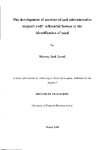The development of secretarial and administrative support staff: influential factors in the identification of need
| dc.contributor.author | Lovell, Murray Jack | |
| dc.contributor.other | Plymouth Business School | en_US |
| dc.date.accessioned | 2013-11-05T11:00:36Z | |
| dc.date.available | 2013-11-05T11:00:36Z | |
| dc.date.issued | 1999 | |
| dc.identifier | NOT AVAILABLE | en_US |
| dc.identifier.uri | http://hdl.handle.net/10026.1/2587 | |
| dc.description | Merged with duplicate record 10026.1/583 on 27.02.2017 by CS (TIS) | |
| dc.description.abstract |
Radical advances in microelectronics applications during the 1970's precipitated rapid developments in new office technology which was held to threaten the very existence of the traditional secretarial task role. Many contemporary commentators conceived a correlative link between the emergence of the new technology and the displacement of administrative support staff, whilst others predicted that a form of "Taylorism" was about to invade the office environment with all manner of dehumanising connotations. The reality proved somewhat different and, far from eradicating the role of the secretary or reducing it to assembly-line proportions, the technology helped to facilitate the flattening of organisational structures, thereby exposing secretaries to new opportunities as they asserted control over the new communications. Companies subsequently perceived the benefits of horizontally enlarging secretarial roles to encompass paraprofessional activities such as personnel, finance, sales and marketing, etc., or vertically extending them to undertake supervisory or monitorial tasks that were previously the domain of functional managers. Thus, the training and development of secretarial and administrative support staff became of paramount importance, yet this was frequently left to the vagaries of chance, to the whim of management, or to questionable analytical practices. The following thesis discusses the role of the secretary in its inner and outer context and explores the literature to ascertain weaknesses in contemporary approaches to needs analysis. Moreover, from a survey of Times Top 1,000 Companies, it examines the forces for change that are influencing these organisations and charts the ways that secretarial and administrative support staff are increasingly addressing performance gaps in corporate indices of effectiveness. Equally, in combining a survey of secretaries, it establishes the range of competencies that are considered important in reconciling individual, task and organisational goals and suggests a diagnostic procedure that might effectively accomplish this without the biases and concerns that have resolutely pervaded needs analysis methodologies. | en_US |
| dc.language.iso | en | en_US |
| dc.publisher | University of Plymouth | en_US |
| dc.title | The development of secretarial and administrative support staff: influential factors in the identification of need | en_US |
| dc.type | Thesis | |
| plymouth.version | Full version: final and full version as approved by the examiners at the time of the award of your degree | en_US |
| dc.identifier.doi | http://dx.doi.org/10.24382/1589 | |
| dc.identifier.doi | http://dx.doi.org/10.24382/1589 |
Files in this item
This item appears in the following Collection(s)
-
01 Research Theses Main Collection
Research Theses Main


